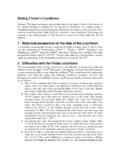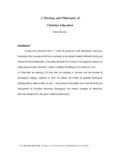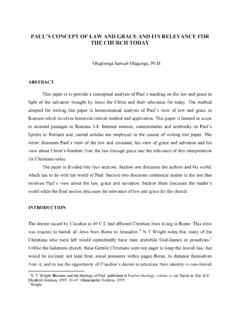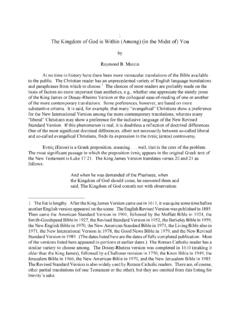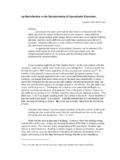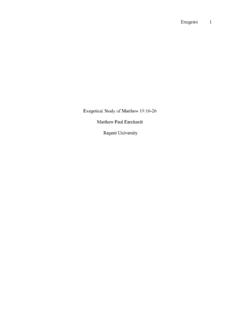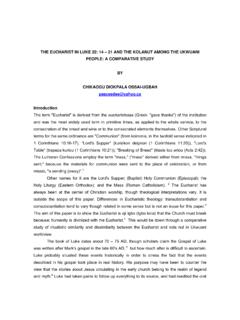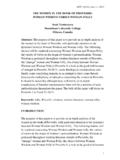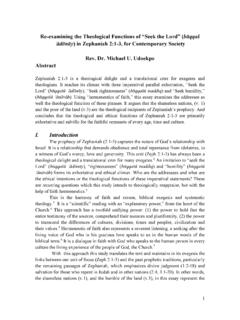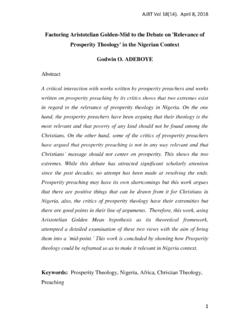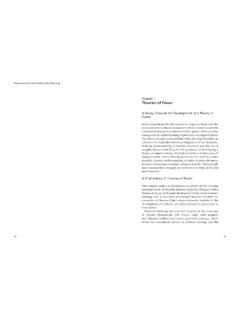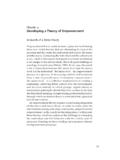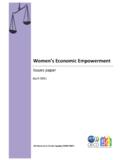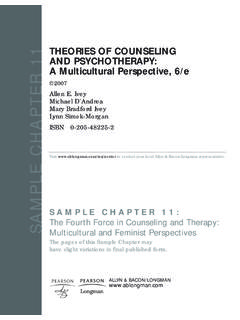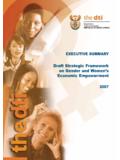Transcription of Divine Empowerment: Interpretation through the …
1 Divine empowerment 1 Running head: Divine empowerment Divine empowerment : Interpretation through the Exegesis of Acts 2 Daryl D. Green Regent University Divine empowerment 2 Abstract This paper explores the Divine empowerment of Christian leaders in early and contemporary Christianity by utilizing an intertexual analysis of Acts 2. through this scholarly transaction, an investigation will determine how Luke used the Old Testament concept of Divine empowerment of leaders to proclaim legitimate leadership. The specific outcome of this paper will demonstrate (a) a familiarity with text of Acts 2, (b) a competence in intertexual analysis, and (c) an awareness of the principles of leadership empowerment in the early church and contemporary living. This effort will contribute to further exploration into the application of biblical text to leadership issues in organizations.
2 Divine empowerment 3 Glancing into the darkness of night, individuals can behold the wonders of life. Stars guard the universe. Each star is special and holds an important position in the heavens. Like humans, stars come to life, serve their purpose, and later die. Some stars live a meaningless existence with the same daily routine. On the contrary, a Super Nova is a special star and carries a peculiar behavior. This star begins as a cosmic cloud, loaded with cosmic particles. It continues to mature and grow in size, acting as enormous nuclear furnaces. Unlike other stars that quietly fade into oblivion, a Super Nova has a different pathway. In its last days, a Super Nova gains an enormous amount of energy that liberates it. The Super Nova experiences a sudden burst of radiant energy that generates enormous luminosity beyond its original state.
3 The universe recognizes when a Super Nova has completed its mission. During these turbulent times of the 21st century, organizations are yearning for leaders who will provide a special illumination to their followers. Increasingly, America has witnessed the tearing away of the moral fabric of its institutions. Postmodern culture continues to heavily influence youth culture in ways that youths find themselves challenging authority and absolutes. This pessimistic and cynical behavior has also placed a dark cloud over the Divine calling of contemporary leaders. On the contrary, Christians have been warned for ages of impending danger on society. In 2 Timothy 3:1-5, Paul clearly explains the darkening of the times: ..in the last days there will come times of stress. For men will be lovers of self, lovers of money, proud, arrogant, abusive, disobedient to their parents, ungrateful, the form of religion but denying the power of it.
4 Avoid such people. Divine empowerment 4 Fortunately, leaders can provide followers with the same liberating feelings found in the explosion of a Super Nova when leaders are divinely empowered. Every progressive organization should seek to empower their leaders as well as their followers. Biblical truths can fill this spiritual gap by renewing and invigorating organizational spirits. Therefore, the focus of this study will be to explore the Divine empowerment of Christian leaders in early and contemporary Christianity by applying an intertexture analysis of Acts 2. Background The Acts of the Apostles. Acts provides an eyewitness account of the early beginnings of the church. The purpose of this book is to give an accurate account of the birth and growth of the Christian church (Life Application Study Bible, 1991). Written by Luke as a continual to his Gospel, Acts serves as an accurate historical record of the church.
5 Religious scholars debate, however, whether the Western text type or the Alexandrian one clearly interprets what Luke wrote (Witherington, 1998). Acts is the connecting link between Christ s life and the life of the church, between the Gospel and Letters. The book of Acts continues the story Luke began in his Gospel, covering the 30 years after Jesus was taken up into heaven. Many writers link both Luke and Acts together because it is generally believed that these books have a common author (Witherington, 1998). The characteristics of these books imply that the author was following ancient Greek historiographical conventions because both books are symmetrical in nature (Witherington, 1998). In the opening of Acts, the writer greets Theophilus, which means in Greek, friend of God. The Gospel of Luke also addresses Theophilus. Some critics argue about the authenticity of Acts. In many cases, the information contained in Acts cannot be checked with other historical information.
6 Schultz (2002) argued that this historical incompleteness is thus a mechanism of the Holy Spirit. As matter of fact, during the nineteenth century, a Divine empowerment 5 dominating view was that Luke provided a very biased picture of the apostolic times (Keck & Leander, 1996). Much is known about the writer Luke. Luke has been exclusively viewed as a historian (Keck & Leander, 1996). However, much of the biblical information about Luke comes from the Apostle Paul (Schultz, 2002). It is postulated that Luke wrote after the fall of Jerusalem and his written work produced between 75 and 90 (Keck & Leander, 1996). There is also no similar historical record about the last third of the first century when the church moved beyond eyewitness testimony (Witherington, 1998). With all of these negative points to consider, Christians have the Acts of the Apostles to provide a story of the establishment and growth of the Christian church.
7 Although the detailed accounts are not listed for the apostles, Luke manages to mention the Holy Spirit 57 times in the book (Schultz, 2002). Therefore, the Holy Spirit is a critical part of the puzzle for the early church. The Psalms. The Book of Psalms provides an avenue for poetic literature and wisdom for daily living. The objective of these writings is to address mankind s need of salvation in all realms of his life. In Psalms, Chapter 16, the date of publication cannot determined, but David is considered to be the author. On the contrary, Herrick (2005) argued that the authorship and date cannot be determined from the Old Testament context. The term Miktam means to cover and therefore A miktam of David could mean David s psalm of atonement or prayer. Therefore, the summary of this psalm focuses on the joys and benefits of a life lived in companionship with God (Life Application Study Bible, 1991).
8 Joel. The Book of Joel gets its name from the prophetic writer Joel, which is a combination of two names for God--Yahweh and Elohim. It means Yahweh is God. It must be considered that most noted Old Testament translated into Greek was the Septuagint (also known as the LXX); most scholars agree that there are differences in style and qualities within the LXX Divine empowerment 6 (The Greek Septuagint, ) Little is known about this prophet other than being the son of Pethuel (Joel 1:1) and being from Judah (Malick, 2005). Joel is listed with the Minor Prophets in the Hebrew Canon, right after the Books of Ezekiel and Hosea. It is assumed that the time of Joel s preaching was in the late pre-exilic timeframe, about 609-586 (Malick, 2005). The purpose of this book was to warn Judah of God s impending judgment due to their sins and to provide an avenue for repentance.
9 Joel found himself in a place where his people had taken God for granted. They had become self absorbed, and Joel spoke to this issue by stating this lifestyle would eventually gain God s judgment (Life Application Study Bible, 1991). In Chapter 2, Joel prophesies the terrible desolation of Judah. Joel also provides a serious call to the people to repent and return to God in hopes of Him displaying mercy. Joel further predicts the establishment of the Messiah s kingdom in the world by the pouring out of the Spirit in latter days (Henry, 1712). Method In evaluating the sacred text of Acts 2, socio-rhetorical criticism, a method that can assist in understanding scriptures, was utilized. Some biblical scholars object to using exegesis techniques for the book of Acts for the following reasons: (a) socio-scientific studies are almost non-existent, (b) historical criticism is the dominant method for scientific investigation of the Bible, and (c) the nature of Acts is a problem by itself (Estrada, 2004).
10 In spite of these limitations, socio-rhetorical provides a greater scholarly depth. Socio-rhetorical criticism integrates the methods people use language with the manners they live in the culture (Robbins, 1996). It exhibits five different angles to explore multiple textures within the texts: (a) inner texture, (b) intertexture, (c) social and culture texture, (d) ideological texture, and (e) sacred Divine empowerment 7 texture (Robbins, 1996). For this study, intertexture analyses will be fully utilized. Intertexture focuses on the interaction of the language in the text with outside material, historical events, texts, customs, values, roles, institutions, and systems (Robbins, 1996). The analysis will employ the following techniques: Oral-Scribal and Historical Intertextures. Analysis and Findings of Study Intertexture Analysis Historical Intertexture.
